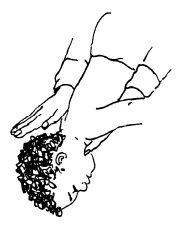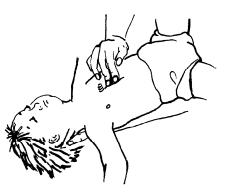Choking infant (up to 1 year)
Article Translations: (Spanish) (Hmong) (Somali)
How can I prevent choking?
Choking is most common in children younger than 5 years. Cut up their food into small pieces, and be sure to watch them closely when eating. Do not allow them to have food or small objects in their mouth while running, talking, crying, or laughing. Some common things children choke on include:
- buttons, coins
- grapes, raw carrots
- hot dogs
- hard candy, peanuts, popcorn
- latex balloons
- small toys or pieces of toys
What are the signs of choking?
- high-pitched noisy breathing
- cough is very quiet
- cannot make sounds
- color changes from red to purple to blue
- cannot breathe
What should I do?
- Back slaps:
- Support head, neck, and jaw with 1 hand.
- Turn baby face down on your arm.
- Sit or kneel and rest your arm on your lap or thigh.
- Using the heel of your hand, give up to 5 back slaps between the shoulder blades.

- Chest thrusts:
- Turn baby face up onto your other arm, supporting the head and neck.
- Give up to 5 chest thrusts, using 2 fingers just below the nipple line.

Repeat steps 1 and 2 until the baby can breathe, cough, or cry, or does not respond.
If the infant does not respond
- 1. Yell, "Help - call 911!"
- Do CPR, but each time you open the airway to give breaths, look for an object in the mouth. If you see something, remove it. If nothing is seen, do not put your fingers in the mouth.
- Continue CPR until the baby responds, or trained help takes over.
Important
This is a review of techniques taught in a class on managing choking. It is not complete in itself. You must practice these techniques on a manikin with an instructor. Do not practice techniques on a person.
Questions?
Children's Minnesota
Patient/Family Education
2525 Chicago Avenue South
Minneapolis, MN 55404
Last Reviewed Respiratory 3/2023 ©Copyright
This page is not specific to your child, but provides general information on the topic above. If you have any questions, please call your clinic. For more reading material about this and other health topics, please call or visit Children's Minnesota Family Resource Center library, or visit www.childrensmn.org/educationmaterials.
© 2024 Children's Minnesota
